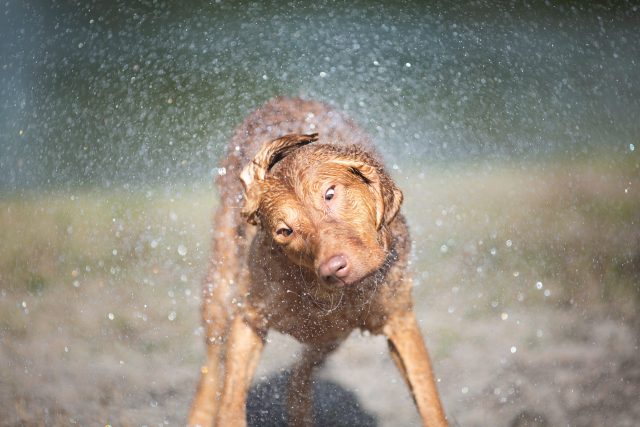With summer full upon us, you and your dog will surely be in the water. Make sure you are aware of ear infections caused by water and what you can do to minimize the risk.
Dr. Annie Li, DVM, a Harvard-trained veterinarian with the Pasadena Humane Society, answered our questions on this common ailment.
How Do Dog’s Get Ear Infections From Water?
Similar to people, when dogs go for a swim, they can accumulate water within their ears. The configuration of their ears differs from humans due to their L-shaped structure, which can make it difficult for water to escape. The moist environment created is a favorable environment for yeast and bacteria, which can then lead to the development of an ear infection, also known as otitis externa.
Does The Type of Ear (pricked, floppy, etc) Make a Difference?
Dogs with floppy ears, such as cocker spaniels and golden retrievers, may be more susceptible to ear infections than dogs with upright ears. Their floppy ears have a tendency to fold over the ear canal to retain moisture inside. Bacteria and yeast thrive in this environment and can cause ear infections.
Veterinarians sometimes joke that if floppy-eared dogs could have their ears pinned to the top of their heads, we could prevent quite a few ear infections by allowing their ears to air out.
Does the type of water make a difference? (i.e. ocean, lake, river, or pool)
Regardless of whether or not a dog goes swimming in the ocean, lake, river, or chlorinated swimming pool, water is still water and can create a favorable environment for microbes to grow in. Thus, all types of water can create moisture that can make a dog more susceptible to an ear infection.
What Are The Signs of An Ear Infection?
A common clinical sign of an ear infection is itchy ears. When bacteria and yeast overgrow within ears, there may be yellow or black debris visible from the ear canal.
The infection can often cause:
- Inflammation or redness of the ear
- Pain at touch
- Head shaking
- Scaly skin within the ear
- Unpleasant odor
What Are Some Ways to Prevent This Type Of Ear Infection?
After a dog swims, allow them to shake out any excess water and dry their ears carefully.
It is also important to regularly clean a dog’s ears when it becomes dirty. The frequency of ear cleaning may vary depending on each dog, so ask your veterinarian. Ear cleansers specifically made for pets are recommended.
Related: 7 Best Ear Cleaners & Wipes for Dogs
Owners can clean their dog’s ears at home by using an ear cleanser that is then wiped off with gauze or cotton. Care should be taken to NOT USE Q-tips due to the possibility of rupturing the tympanic membrane or ear drum.
If a dog has excessive hair within the ears, occasionally tweeze the hair at the groomer’s or veterinarian’s to prevent debris and moisture from accumulating inside.
If an ear becomes infected, veterinary care should be sought for proper treatment.
Are There Ear Plugs For Dogs? Should We Use People Ear Plugs?
Currently, ear plugs are not commonly sold in the market, especially for preventing water from accumulating in a dog’s ears. If earplugs were used, a dog would need to tolerate them. In addition, proper sizing, placement, and removal of an ear plug would be important. Unfortunately, dog ears come in different sizes due to the variety of breeds that exist. Inappropriate sizing, placement, and removal of earplugs could lead to problems, such as losing an ear plug inside the ear canal.
The methods listed above, such as cleaning ears as needed or detecting ear infections early, should be considered the main preventatives available.




